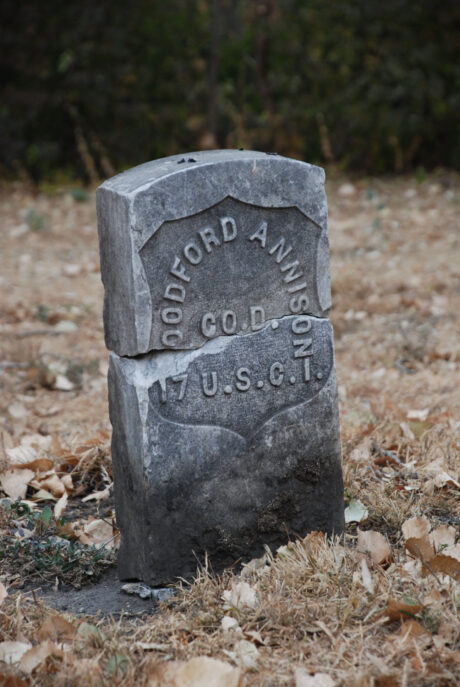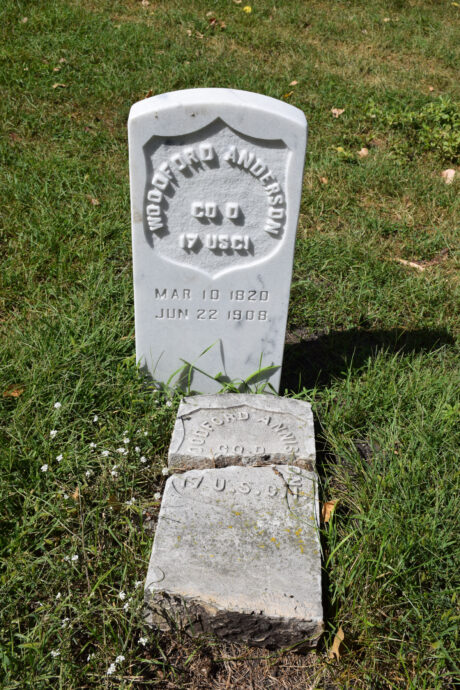from the series Tales from Pioneers and Soldiers Memorial Cemetery…
231st in a Series
By SUE HUNTER WEIR


Woodford Anderson was not a young man when he ran towards freedom. He was enslaved when he was born near Burlington, Kentucky, on March 10, 1820. When he was 20 years old, he was sold to George Curtley. Curtley, a captain in the Confederate Army, took Anderson to Waverly, Missouri, where Anderson served as a cook. In the fall of 1862, when he was 42 years old, Anderson left Curtley and met up with Union Army soldiers. In a deposition that is included in his 60-page pension file, he said, “I was just following the Union Army as a contraband.”
In May of 1863, Anderson was sent to Fort Snelling in Minnesota. Although he had not formally enlisted at that point, he was sent on Sibley’s expedition to the West where he served as a cook for the 1st Minnesota Mounted Rangers. On March 10, 1864, after he returned to Fort Snelling, he formally enlisted as a private in Company D of the U.S. Colored Troops.
His unit was sent to Nashville, but he was sick most of the time. On June 1, 1865, he was discharged for disability because he suffered from rheumatism and chronic diarrhea. Michael Brady, a fellow soldier, recalled seeing Anderson on the day that he received his discharge: “He had no coat or vest, but he had a paper in his hand and carried a cane. I asked him where he was going, and he said he had just been discharged, and he was going to St. Paul. “The men had not been paid so Anderson hoped to work his way North on a boat. The disabilities that ended his military service would continue to plague him for the rest of his life.
Initially, he was unaware of the problem with his military records, most likely because he could not read or write. As he put it, he always signed papers with his mark (an “X”). Once he learned about the problem, he sought to have it corrected.
Although he undoubtedly arrived in Minnesota several years earlier, Anderson was first listed in the Minneapolis City Directory in 1874. He was employed as a barber, the occupation that he held for most of his working life. He married three times, but each of those marriages ended in divorce.
By 1890, his health had deteriorated. He had heart trouble, difficulty breathing, and was losing his sight. He never sought medical treatment but, instead, treated himself with patent medicines and liniments. He qualified for a disability pension under the recently passed Dependent and Disabilities Act. Prior to the passage of that Act, veterans had to prove that their disability was caused by their military service. The new Act required only that a soldier had served for 90 days, had been honorably discharged, and was disabled, even if his disability was not war related, Claims could still be denied if the disability was caused by “vicious habits.” Anderson’s clearly were not. Horace Carlisle, a prominent member of Minneapolis’ African-American community and the brother-in-law of John Cheatham, Minneapolis’ first Black firefighter, was one of those who testified on Anderson’s behalf. The other was John Thomas. They both described Anderson as a man of good moral character. Still, getting his application approved was not an easy task.
He first had to establish that he was who he said he was. Even though he had never gone by any name other than Woodford Anderson, his military records are under Woodruff Annison. He also was variously referred to as Woodruff Anderson and Woodford Annison. Four variations for the same man. Initially, he was unaware of the problem with his military records, most likely because he could not read or write. As he put it, he always signed papers with his mark (an “X”). Once he learned about the problem, he sought to have it corrected.
A special examiner was assigned to sort things out. He believed Anderson’s claim, describing him as a man” having a good memory and [seeming] intelligent” whose “reputation for the truth was fair.” He took depositions from two of Anderson’s fellow soldiers, who swore that they had always known him as Woodford Anderson. One of those men was Amos Watkins, an African-American Civil War veteran, who is also buried in the Cemetery. Watkins, like Anderson, was a barber and had employed him off and on over a period of many years, even when Anderson was too sick to work.
Anderson’s 1890 request for a pension was approved after a ten-month wait. He was awarded $6.00 a month (about $208 in today’s dollars). In 1897, as he became increasingly disabled, he requested an increase and was granted $8.00 a month. On December 31, 1907, Anderson’s pension was increased to $12.00 a month. He died a little over six months later.
Woodford Anderson died on June 19, 1908, at the age of 88 years, three months and nine days. The official cause of death was recorded as valvular heart disease. A military marker bearing the name Woodford Annison was placed on his grave in the late 1930s. At some point, that marker broke. We replaced it in 2019.. His new marker correctly shows his name as Woodford Anderson.
Sue Hunter Weir is chair of Friends of the Cemetery, an organization dedicated to preserving and maintaining Minneapolis Pioneers and Soldiers Memorial Cemetery. She has lived in Phillips for almost 50 years and loves living in such a historic community.









